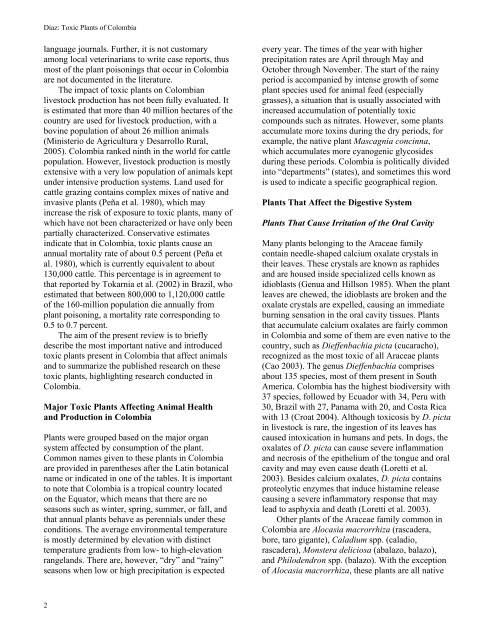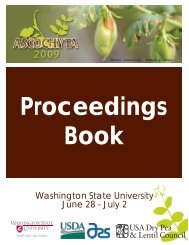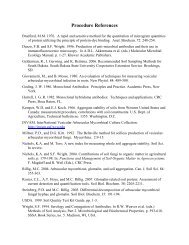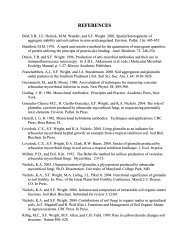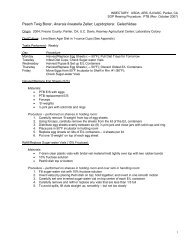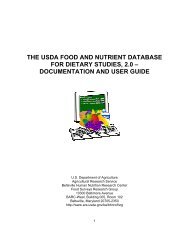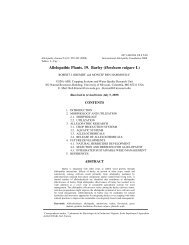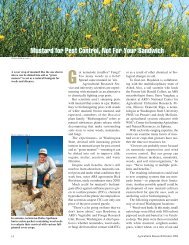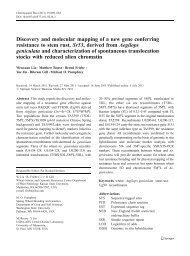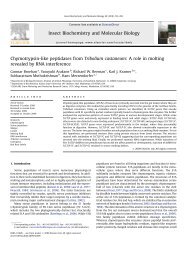International Journal of Poisonous Plant Research - Agricultural ...
International Journal of Poisonous Plant Research - Agricultural ...
International Journal of Poisonous Plant Research - Agricultural ...
Create successful ePaper yourself
Turn your PDF publications into a flip-book with our unique Google optimized e-Paper software.
Diaz: Toxic <strong>Plant</strong>s <strong>of</strong> Colombia<br />
language journals. Further, it is not customary<br />
among local veterinarians to write case reports, thus<br />
most <strong>of</strong> the plant poisonings that occur in Colombia<br />
are not documented in the literature.<br />
The impact <strong>of</strong> toxic plants on Colombian<br />
livestock production has not been fully evaluated. It<br />
is estimated that more than 40 million hectares <strong>of</strong> the<br />
country are used for livestock production, with a<br />
bovine population <strong>of</strong> about 26 million animals<br />
(Ministerio de Agricultura y Desarrollo Rural,<br />
2005). Colombia ranked ninth in the world for cattle<br />
population. However, livestock production is mostly<br />
extensive with a very low population <strong>of</strong> animals kept<br />
under intensive production systems. Land used for<br />
cattle grazing contains complex mixes <strong>of</strong> native and<br />
invasive plants (Peña et al. 1980), which may<br />
increase the risk <strong>of</strong> exposure to toxic plants, many <strong>of</strong><br />
which have not been characterized or have only been<br />
partially characterized. Conservative estimates<br />
indicate that in Colombia, toxic plants cause an<br />
annual mortality rate <strong>of</strong> about 0.5 percent (Peña et<br />
al. 1980), which is currently equivalent to about<br />
130,000 cattle. This percentage is in agreement to<br />
that reported by Tokarnia et al. (2002) in Brazil, who<br />
estimated that between 800,000 to 1,120,000 cattle<br />
<strong>of</strong> the 160-million population die annually from<br />
plant poisoning, a mortality rate corresponding to<br />
0.5 to 0.7 percent.<br />
The aim <strong>of</strong> the present review is to briefly<br />
describe the most important native and introduced<br />
toxic plants present in Colombia that affect animals<br />
and to summarize the published research on these<br />
toxic plants, highlighting research conducted in<br />
Colombia.<br />
Major Toxic <strong>Plant</strong>s Affecting Animal Health<br />
and Production in Colombia<br />
<strong>Plant</strong>s were grouped based on the major organ<br />
system affected by consumption <strong>of</strong> the plant.<br />
Common names given to these plants in Colombia<br />
are provided in parentheses after the Latin botanical<br />
name or indicated in one <strong>of</strong> the tables. It is important<br />
to note that Colombia is a tropical country located<br />
on the Equator, which means that there are no<br />
seasons such as winter, spring, summer, or fall, and<br />
that annual plants behave as perennials under these<br />
conditions. The average environmental temperature<br />
is mostly determined by elevation with distinct<br />
temperature gradients from low- to high-elevation<br />
rangelands. There are, however, “dry” and “rainy”<br />
seasons when low or high precipitation is expected<br />
2<br />
every year. The times <strong>of</strong> the year with higher<br />
precipitation rates are April through May and<br />
October through November. The start <strong>of</strong> the rainy<br />
period is accompanied by intense growth <strong>of</strong> some<br />
plant species used for animal feed (especially<br />
grasses), a situation that is usually associated with<br />
increased accumulation <strong>of</strong> potentially toxic<br />
compounds such as nitrates. However, some plants<br />
accumulate more toxins during the dry periods, for<br />
example, the native plant Mascagnia concinna,<br />
which accumulates more cyanogenic glycosides<br />
during these periods. Colombia is politically divided<br />
into “departments” (states), and sometimes this word<br />
is used to indicate a specific geographical region.<br />
<strong>Plant</strong>s That Affect the Digestive System<br />
<strong>Plant</strong>s That Cause Irritation <strong>of</strong> the Oral Cavity<br />
Many plants belonging to the Araceae family<br />
contain needle-shaped calcium oxalate crystals in<br />
their leaves. These crystals are known as raphides<br />
and are housed inside specialized cells known as<br />
idioblasts (Genua and Hillson 1985). When the plant<br />
leaves are chewed, the idioblasts are broken and the<br />
oxalate crystals are expelled, causing an immediate<br />
burning sensation in the oral cavity tissues. <strong>Plant</strong>s<br />
that accumulate calcium oxalates are fairly common<br />
in Colombia and some <strong>of</strong> them are even native to the<br />
country, such as Dieffenbachia picta (cucaracho),<br />
recognized as the most toxic <strong>of</strong> all Araceae plants<br />
(Cao 2003). The genus Dieffenbachia comprises<br />
about 135 species, most <strong>of</strong> them present in South<br />
America. Colombia has the highest biodiversity with<br />
37 species, followed by Ecuador with 34, Peru with<br />
30, Brazil with 27, Panama with 20, and Costa Rica<br />
with 13 (Croat 2004). Although toxicosis by D. picta<br />
in livestock is rare, the ingestion <strong>of</strong> its leaves has<br />
caused intoxication in humans and pets. In dogs, the<br />
oxalates <strong>of</strong> D. picta can cause severe inflammation<br />
and necrosis <strong>of</strong> the epithelium <strong>of</strong> the tongue and oral<br />
cavity and may even cause death (Loretti et al.<br />
2003). Besides calcium oxalates, D. picta contains<br />
proteolytic enzymes that induce histamine release<br />
causing a severe inflammatory response that may<br />
lead to asphyxia and death (Loretti et al. 2003).<br />
Other plants <strong>of</strong> the Araceae family common in<br />
Colombia are Alocasia macrorrhiza (rascadera,<br />
bore, taro gigante), Caladium spp. (caladio,<br />
rascadera), Monstera deliciosa (abalazo, balazo),<br />
and Philodendron spp. (balazo). With the exception<br />
<strong>of</strong> Alocasia macrorrhiza, these plants are all native


